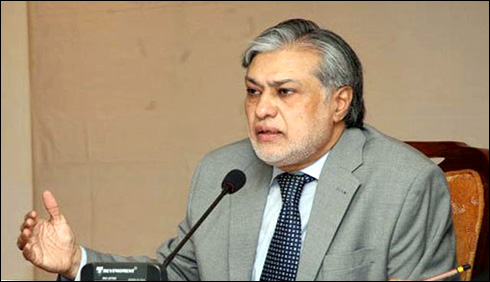ISLAMABAD
Ministry of Finance through a statement issued here on Friday has rejected the allegations levelled by leaders of Pakistan Tehrik-e-Insaf (PTI) during a press conference on Thursday. PTI leaders had criticised the economic performance of the government.
According to the finance ministry, the PTI leaders instead of taking a holistic view of the economy, presented a distorted picture of selected economic indicators, while deliberately ignoring many important milestones achieved in the economy.
The ministry claimed GDP had reached the lowest level of 0.36 per cent in 2008 and thereafter growth remained patchy with an average of 2.8 per cent between, 2008 and 2013. Inflation was in double digits in 2008-09 reaching the highest level in the history of 25.3 per cent in August 2008. Overall, during 2008-2013 inflation on average hovered above 12 per cent. The policy rate was as high as 14 per cent in 2008-09. The agriculture credit disbursement in 2008-09 was Rs 233.1 billion while on average it was at Rs 264.3 billion between, 2008 and 2013. Forex reserves were at historically low levels and there were predictions of Pakistan going into default. Doors were closed by various multilateral and bilateral agencies for funding program. Credit rating agencies like S&P and Moody’s had downgraded Pakistan’s ratings.
Pakistan has seen a visible economic improvement during the last four years, due to the successful implementation of a comprehensive programme of economic revival aimed at higher economic growth and macroeconomic stability.
According to the ministry’s rebuttal, GDP growth which was very unstable during 2008-13 has now been stabilised. In FY2014 GDP growth crossed 4 per cent at a time when the country was confronted with a number of security challenges and settlement of IDP’s issues. Despite challenges, the growth momentum remained above 4 per cent for the last three years in a row and reached a decade high of 5.3 per cent in 2017.
The performance of the banking sector has also remained impressive. Its asset base reached Rs 15.831 trillion by end December 2016 compared to Rs. 10.487 trillion by end December 2013, registering a growth of 50.9 per cent.
Total investment increased by 50.1 per cent over FY 2013. It increased from Rs 3,348.3 billion in FY2013 to Rs 5,026.8 billion while as the percentage of GDP it increased from 14.96 per cent in FY2013 to 15.78 per cent in FY2017.
Worker’s remittances increased from $ 13.9 billion in FY2013 to $ 19.3 billion in FY2017. Unlike the claims made in the press conference, FDI improved from $ 1.456 billion in FY2013 to $ 2.410 billion in FY2017, thus posting a growth of 65.5 per cent.
The foreign exchange reserves which were at the lowest level of $ 7.58 billion in February 2014 have increased to $ 20.304 billion as by September 2017.
Fiscal deficit reduced to 5.8 per cent in FY2017 against 8.2 per cent of GDP in FY2013, despite an increase in development and social protection spending.
Due to these improvements in the economy, the international credit rating agencies increased Pakistan’s credit ratings.
In BISP the number of beneficiaries has increased from 3.7 million in FY2013 to 5.6 million in 2017. Its allocation increased from Rs 40 billion in FY 2103 to Rs 121 billion this year. Poverty has been reduced.
Pakistan and IMF successfully completed the Extended Fund Facility (EFF) program which indicates government’s commitment in implementing structural reforms in the areas of taxation, energy, monetary and financial sectors as well as public sector enterprises.
With regard to debt, the claim that PML-(N) government borrowed record Rs 10.8 trillion is incorrect and based on incorrect projections. The statement is only intended to mislead the general public by including projections of such debt and liabilities which are not part of government debt.
Regarding the claim that ‘our’ export has gone down while exports from India and Bangladesh increased is not correct as almost all countries suffered downward trend due to overall depressed world economic growth.
With regard to the claim that direct taxes had registered a decline, it is clarified that the share of direct taxes in total taxes has increased over the years. In 1990-91 the direct taxes were just around 20 per cent of total taxes. It increased to 31.1 per cent in 2004-05. In FY 2016-17 the share of direct taxes reached at 40 per cent and it has become the single largest tax collected by FBR. The government is focused on further increasing the share of direct taxes through various policy and administrative reforms including broadening the tax base.
The pendency of total sales tax refund claims as on 30-06-2017 is to the tune of Rs 139 billion which was 3.9 per cent of revenue target of Rs 3,521 billion for the year 2016-17.
PTI’s views on the economy are an attempt to sensationalise the public by presenting a very bleak picture of the economy which merely reflects their negative approach to things, it was further added.
The rebuttal also added that before the present government, energy outages were common. Cities faced load shedding of 12 to 14 hours while in rural areas it was 16 to 18 hours.
The average shortfall stood at 5,000 MWs prior to PML-N tenure, which has been reduced by effective management of resources to a level of 2,000 MWs and is likely to be eliminated by end of 2017.

























